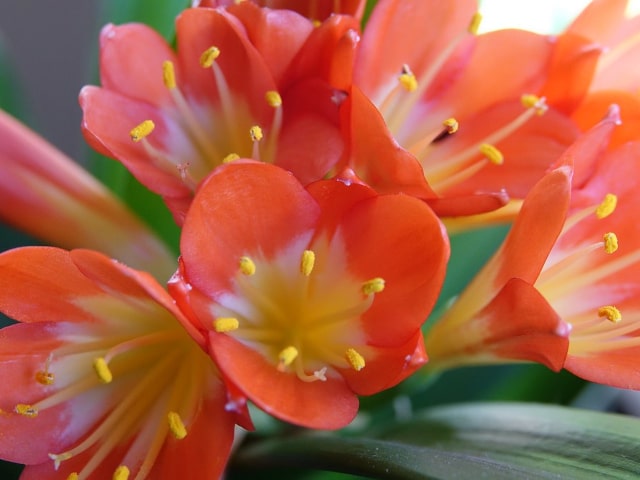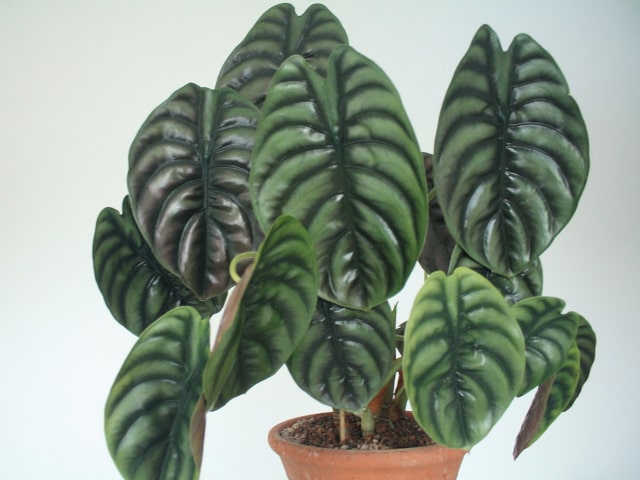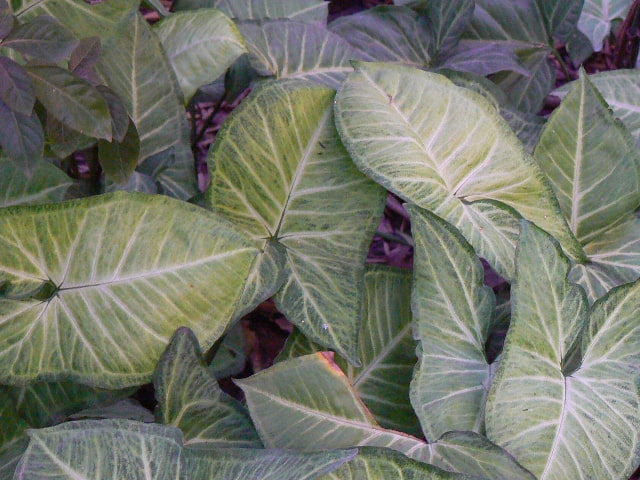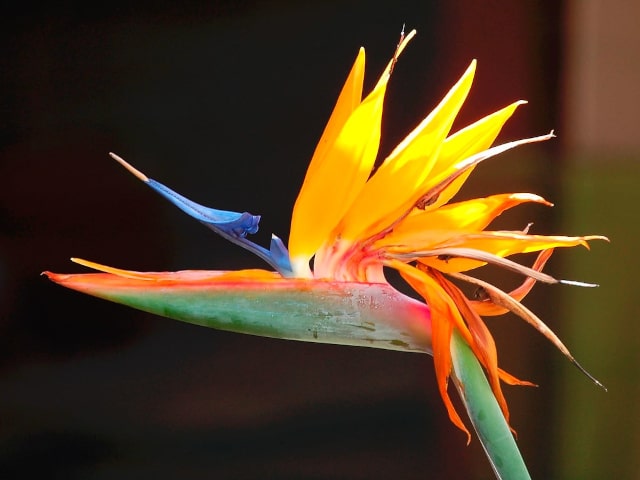
The clivia plant, also known as kafir-lily is a beautiful houseplant you can grow relatively easily. The clivia plant has heavy textured green strap-like leaves. The flowers are smooth petaled, with varied colors ranging from brick red to salmon, red and yellow. It is truly a beautiful indoor houseplant.
The clivia plant is a relative to the amaryllis. It grows from thick, tuberous roots rather than a true bulb, though people often refer to the clivia bulb when they talk about these plants. The "bulb" generally grows slowly. It's seldom listed in the plant bracket so it may not look gorgeous when you first spot it in the garden center. However, it's a plant that will last you for years, even more than a decade. It's not surprising to hear some 15 years and older clivia plants people grow in their homes. It doesn't deteriorate with age: on the contrary, these old plants can still produce beautiful flowers and only increase in beauty.
Another thing you need to know is that these plants have evergreen foliage and their flowers look stunning. You can use clivia plants to add color to your home and they make a very good investment.
Clivia Plant Care Requirements
The first thing you need to know about growing clivia plants is that they require rich potting soil with a bit peat added to the mix. Make sure to never repot your clivia until the fleshy roots have entirely outgrown the pot.
Once it's established, a cliva plant needs regular food to thrive. You should feed it during its growth period and make sure to provide it with plenty of water. During the growing season, the bulbs require temperatures of about 60 to 80 degrees F. In the winter, tolerable temperatures range between 50 and 55 degrees F.
There are 3 or 4 popular species of clivia plants, as well as several common hybrids. The most popular of them all (and the one that's most often listed in catalogs) is Clivia miniata. It has its active growth period in early spring to early fall.
During this time (the growing season), your clivia plant will need a lot of warmth, light, water and fertilization. Average home temperatures of about 70 to 75 degrees F and about a ten degree drop at night are the best and will make the plant thrive. These temperatures match the conditions in the plant's native South Africa.
To make your clivia thrive, it's best to place it near an east or south window. It will promote good growth.
Resting Your Clivia Plant
In the late fall and early winter you should make your clivia plant rest. Place it in a cool room where temperatures don't go above 50 degrees F. Since modern homes are generally well-heated during winter, you may have some problem finding a suitable room to rest your clivia. You may use a partially heated porch or glazed-in patio. Another good place is a north wall in a cool basement. While you keep the plant in storage don't forget to decrease its water supply.
In mid-January bring your clivia to the light. This is when you should give them a good soaking with water. The plant will soon show new center leaves. When the new growth starts, make sure to give your plant a weekly feeding of one fourth strength soluble liquid food. Read the manufacturer's instructions carefully to determine the right proportions.
Your clivia plant should bloom in April, but it may not flower until June or even early July.
One note about flowers: some people like clivia for its foliage so they keep their plant in the window garden (or a planter) for the whole year. It's important to note that this won't hurt the plant. However, your clivia will probably not grow under such treatment. It is less likely to produce annual spring or summer flower crop. If you want your clivia to bloom, make sure to rest it during winter and to move it from the window, as described above.
Potting and Dividing Clivia
When you purchase your clivia from a catalogue chances are that it will be shipped bare root and wrapped. It means you have to plant it in your home. Clivias are relatively large so they require 6 to 8 inch pots.
When planting, remember to place about one inch of drainage material in the pot. Use a soil mix made for amaryllis bulbs (or a similar one).
If you plant your clivia in an 8 inch pot, chances are that you won't need to repot it for 5 or 6 years. When it develops a new growth each year, make sure to scrape away an inch of the top soil and replace it with fresh soil. This is all you need to do to set it for the year.
To divide your clivia, knock it gently out of the pot. It's best to use a sharp knife to cut away the offsets. When you do it, make sure that you cut plenty of root with them. Plant the offsets in five inch pots of soil. Leave them in there for at least one whole year.
When growing the offsets, give them the same treatment you give to the older plants. You can use knife to cut through sheathed leaves and attached roots. You can plant these divisions in the same way you plant offsets.
Starting from Seeds
You can also make your flowering plant to produce its own seeds. To do it, remove some of the pollen from one flower and place it on the stigma (tip of elongated appendage in the center of the flower) of another flower.
You can plant single seeds in 3 inch pots of sterilized sand and loam. Germination of these seeds is rapid and as the plant matures you can move it to a 5 inch pot of soil and care for it as a division. Under home conditions, it takes about 5 to 7 years to make a clivia bloom from seeds.
How to Grow Clivia Plant Outdoors
If you want to grow your clivia plants outdoors, remember to place the pot in a shady area of your garden. You may also use it for landscaping. It's probably the best to keep it in a container. This way, you can bring it in the house before the first frost.
You may wish to transplant your clivia, but you need to understand that it will usually deter the plant from producing the next year's blooms. Old plants often have 15 to 20 leaves so you will sometimes be forced to transfer you plant to a new pot.
Photo credit: Gerard Stolk




26 Comments
My Cliva's leaves frequently brown at the ends. What is the cause? It gets plenty of direct morning sun and bright light all day.
Should I just cut off the brown ends or remove the entire leaf?
We purchased a 2-leaf Clivia at the 1968 Philadelphia Flower Show. I think I've only repotted it several times and divided it once, giving plants to friends. There are now six plants in the pot and it rewarded us like crazy this spring with three huge, beautiful flowers! Sadly, the last petal just dropped.
Hi, I have some Clivias, they do not bloom every year, well nearly never. They are big full grown. I need to keep them indoors because of out very hot and very cold summers. I move them to a shaded area in summer. I follow the protocol of not watering them in midwinter for up to six weeks, when I start watering them and feeding them with a liquid fertilizer. Can I use a grow light? What else can I do?
Thanks
HJ
Hi there, I have a Clivia plant in little maybe 4 inch pot that I got at the nursery, I did not repot it. Also had some white stuff on it so cleaned it off with peroxide and also put some in the water for it to drink up, but my leaves seem to be yellowing I have been fertilize it every week now. So for the summer should I put it outside side or just leave in the house?
Hi I have an Clivia orange and what do I do with the ovaries on the flower ends?
My plants are blooming but one doesn't have a stem it blooms down in between the leaves. What should I do to help it?
The only cool place I have for overwintering is in the garage, but it needs to go right under a north-facing window. Does it still need darkness if the temps are 35-50 degrees? If so, would draping a lightweight cover over it work?
I have 8 big Clivia plants that were started by my grandmother. I have had them 57 years and they still bloom.
Any suggestions of where I should buy a Clivia plant? None of my local nurseries have any, so maybe there's an online company you can recommend.
Hello, I have a Clovis plant at least five years old. The bulb is above the dirt now should I add dirt?
I have had one Clivia plant for about 10 years never had a bloom. A friend gave me an off shoot of hers and it is doing well growing nicely but after4 years still no bloom I just got a 3rd one and although it is small it is growing well. Please help me to get this one to bloom. Thank you
P.S. I had been told that I should water sparingly... Your directions say water well I live in FL so I never really get a rest period here. Also all plants are potted and out side
I had planted my Clivia tubers in the garden. Once I had two, then next year 3 then next year 4. I moved from the Bay Area in California to the coast in Brookings, Or. I haven't even been here a year yet. Should I still put them in pots, or in the ground? To answer Marilyn, I just cut the tips off of the leaves that turned yellow and deadheaded the spent blooms, the existing stem will reflower in the Spring.
1 I need to know whether I can plant my young Clivia plants in the open sun area?
2. What is the best way to feed my Clivia plants? What would you prescribe as a good feeding substance?
3. My Clivia leaves (foliage) out in the open garden tends to turn brown and and the leaves are sort of soggy. Could you guide me what to do to keep them health y and strong?
Do you cut the flower off when it has finished blooming? Do you cut the stem at the bottom?
I just received a new Clivia in a 4" pot. Should I leave he top part above the soil? If so, how much should be exposed.
I was given two large Clivia plants by a friend. I have never grown one and the leaves on the plants have dry tips. Do you cut the leaves? At the tops or remove the leaf?
My Clivia plant had sticky white thing on their leave and not flowering for two years now. Please help. Thank you
I recently purchased two Clivia plants which had flowers. The stem has now lost its flowers and is turning yellow, The leaves are generally in good condition although one leaf has started to turn yellow. Is there anything I can do to rectify the this problem
Once the flower has stopped flowering when does it flower again, does the flower produce a brand new stem or does the existing stem reflower.